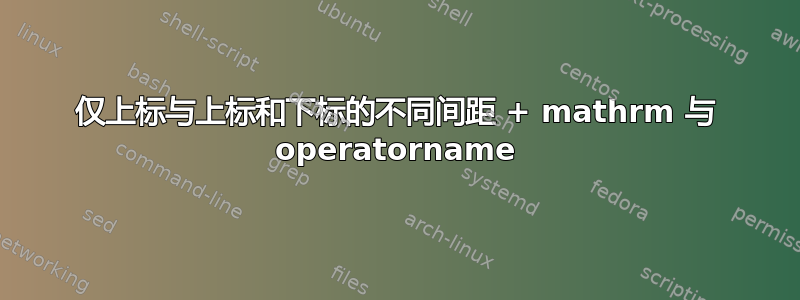
答案1
你可能使用subdepth。但我不推荐它。
\documentclass{article}
\usepackage{amsmath}
\usepackage{subdepth}
\newcommand{\gt}{\mathrm{gt}}
\begin{document}
\[
%%% the following two lines are just to show the alignment
\sbox0{$\displaystyle\mathbf{T}^{\gt}$}
\rlap{\vrule height \dimeval{\ht0+0.1pt} depth -\ht0 width 4cm}
%%%
\mathbf{T}^{\gt}=
\{\mathbf{T}^{\gt}_1,\mathbf{T}^{\gt}_2,\ldots,\mathbf{T}^{\gt}_k\}
\]
\begin{center}
$%%% the following two lines are just to show the alignment
\sbox0{$\displaystyle\mathbf{T}^{\gt}$}
\rlap{\vrule height \dimeval{\ht0+0.1pt} depth -\ht0 width 4cm}
%%%
\mathbf{T}^{\gt}=
\{\mathbf{T}^{\gt}_1,\mathbf{T}^{\gt}_2,\ldots,\mathbf{T}^{\gt}_k\}
$\end{center}
\end{document}
\mathrm gt请注意,无论从哪方面来说,这都是错误的。而且\operatorname在那种情况下也不好。
如果您只有几个这样的构造,那么添加几个会更容易\vphantom。
对于同一结构的多个实例,
\documentclass{article}
\usepackage{amsmath}
\ExplSyntaxOn
\NewDocumentCommand{\tuple}{mm}
{% #1 is the base symbol, #2 is the list of subscripts
#1\sb{\vphantom{#2}} = \{
\seq_clear:N \l_tmpa_seq
\clist_map_inline:nn { #2 }
{
\str_if_eq:nnTF { ##1 } { \dots }
{
\seq_put_right:Nn \l_tmpa_seq { \dotsc }
}
{
\seq_put_right:Nn \l_tmpa_seq { #1\sb{##1\vphantom{#2}} }
}
}
\seq_use:Nn \l_tmpa_seq { , }
\}
}
\newcommand{\gt}{\mathrm{gt}}
\begin{document}
\[
\tuple{\mathbf{T}^{\gt}}{1,2,\dots,k}
\]
\begin{center}
$\tuple{\mathbf{T}^{\gt}}{1,2,\dots,k}$
\end{center}
\[
\tuple{A}{1,2,3} \quad \tuple{B}{1,2,3,\dots}
\]
\end{document}
答案2
我认为此代码是好的解决方案之一:
\documentclass[12pt]{article}
\usepackage{amsmath, amssymb}
\begin{document}
$\mathbf{T}^{\substack{\mathrm{gt}}}_{\phantom{\substack{1}}}=\{\mathbf{T}^{\substack{\mathrm{gt}}}_{\substack{1}},\mathbf{T}^{\substack{\mathrm{gt}}}_{\substack{2}},\ldots,\mathbf{T}^{\substack{\mathrm{gt}}}_{\substack{k}}\}$
\end{document}







